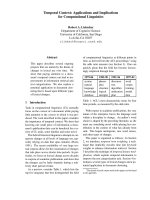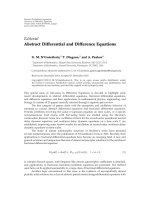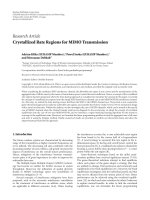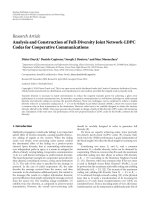Báo cáo hóa học: "Editorial Video Analysis and Coding for Robust Transmission" pot
Bạn đang xem bản rút gọn của tài liệu. Xem và tải ngay bản đầy đủ của tài liệu tại đây (619.6 KB, 3 trang )
Hindawi Publishing Corporation
EURASIP Journal on Applied Signal Processing
Volume 2006, Article ID 53981, Pages 1–3
DOI 10.1155/ASP/2006/53981
Editorial
Video Analysis and Coding for Robust Transmission
Beatrice Pesquet-Popescu,
1
Adriana Dumitras,
2
and Benoit Macq
3
1
Ecole Nationale Superieure des Telecommunications, Paris 75634, France
2
Apple Computer Inc., Cupertino, California, C A 95014, USA
3
Universite Catolique de Louvain, 1348 Louvain la Neuve, Belgium
Received 16 October 2005; Accepted 16 October 2005
Copyright © 2006 Beatrice Pesquet-Popescu et al. This is an open access article distributed under the Creative Commons
Attribution License, which permits unrestricted use, distribution, and reproduction in any medium, provided the original work is
properly cited.
Increasing heterogeneity of networks and diversity of user ca-
pabilities have determined and sustained a strong interest in
robust coding of visual content and flexible adaptation of the
bitstreams to network and user conditions. As a result, sev-
eral methods for robust coding and transmission have been
proposed that include multiple description coding, motion-
compensated subband video coding, joint source-channel
coding, integrated compression and error control, and adap-
tation/transcoding solutions. These typically increase trans-
mission robustness and network and user awareness by using
scalability, error resilience, and adaptivity at little or some-
times no extra cost in coding efficiency.
However, the performance of these methods is affected
by the diversity of, and complex interactions within, the vi-
sual content. Analysis methods can improve the performance
of robust methods for coding and transmission by provid-
ing solutions to account for vastly different characteristics
of the visual content and complex interactions among data
components, to achieve optimal or near-optimal robust solu-
tions. Among several benefits, the application of visual anal-
ysis methods within robust coding and transmission frame-
works such as those mentioned earlier yields content-aware
error resilient solutions and improves prioritization of the
visual content for coding and transmission.
This special issue focuses on the seamless integration of
visual analysis methods in, or joint design with, robust com-
pression and t ransmission solutions. The special issue con-
sists of three sections that address robust video coding archi-
tectures and configurations, robust entropy coding methods,
and quality issues related to robust coding, respectively:
(a) robust v ideo coding paradigms (multiple description
coding, motion-compensated subband coding, dis-
tributed coding, and cross-layer designs),
(b) robust entropy coding by variable length codes, and
(c) quality issues in robust coding (error resilience, error
concealment, and quality evaluation).
In the first set of nine papers, the first three address multi-
ple description coding methods. T he paper “End-to-end rate-
distortion optimized MD mode selection for multiple de-
scription video coding” by B. A. Heng et al. discusses an
adaptive approach to multiple description coding by a rate-
distortion optimized selection of the most appropriate mul-
tiple description mode, dep ending on the network condi-
tions and video features. The proposed method is an H.264-
compatible video streaming solution over bursty channels
and is based on an encoder-side estimation of the end-to-
end distortion. The paper “Multiple description wavelet cod-
ing of layered video using optimal redundancy allocation” by
N. V. Boulgouris et al. presents a wavelet-based, predictive,
multiple description scheme with drift-free reconstruction.
In this work, the redundancy allocation problem is tackled
as a maximization of the average quality under a total target
bitrate constraint. The paper “Unbalanced quantized multi-
state video coding” by S. E. Flierl et al. discusses a multiple
description coding method that uses multistate video coding
(or subsequence splitting). Unbalanced quantized descrip-
tions are designed in this work using a rate-distortion opti-
mization model based on network and video characteristics.
Within the same section of robust video coding
paradigms, the fourth and fifth papers address motion-
compensated subband techniques. The paper “Temporal scal-
ability through adaptive M-band filter banks for robust
H.264/MPEG-4 AVC video coding” by C. Bergeron et al. pro-
poses several temporal scalability schemes obtained by frame
shuffling that increase robustness in an H.264-compatible
framework. This work discusses open-loop and closed-loop
architectures in an adaptive M-band hierarchical filter bank
framework, and analyzes the sender-side error propagation.
2 EURASIP Journal on Applied Signal Processing
The paper “Motion estimation and signaling techniques for
2D+t scalable video coding” by M. Tagliasacchi et al. presents
a 2D + t (in-band) video coding method with fast motion
estimation in the wavelet domain and an adaptive in-band
version of the update lifting step.
The distributed source coding paradigm is the focus
of the sixth and seventh papers on robust video coding
architectures and paradigms. The paper “Distributed cod-
ing of highly correlated image sequences with motion-
compensated temporal wavelets” by M. Flierl and P. Van-
dergheynst makes use of motion-compensated temporal fil-
tering subband codecs in a multiple camera distributed
video coding system. The paper investigates the relation-
ship between multiview side information and temporal de-
correlation, and proposes an optimal motion-compensated
spatiotemporal transform at high bitrates. The work in “A
framework for adaptive scalable video coding using Wyner-
Ziv techniques” by H. Wang et al. presents a practical, low-
complexity distributed coding framework, wh ich exploits a
multilayer Wyner-Ziv prediction “link” that connects the
same bitplane level b etween successive planes. Such a link is
created by exploiting the high quality reconstruction of the
previous frame in the enhancement layer coding of the cur-
rent frame, and provides improved temporal prediction as
compared to MPEG-4 FGS, while maintaining a reasonable
complexity on the encoder side.
The eighth and ninth papers of the robust video cod-
ing paradigms provide useful guidelines for the cross-layer
design of wireless video systems. The paper “Robust sys-
tem and cross-layer desig n for H.264/AVC-based wireless
video applications” by T. Stockhammer focuses on the fea-
ture selection for an H.264 codec, and the transport and
network parameters for real-time applications. The paper
“Source-adaptation-based wireless video transport: A cross-
layer approach” by Q. Qu et al. proposes a forward error cor-
rection/unequal error protection method, which adapts the
H.264 source coding to the motion information. This solu-
tion allows the system to better cope with bursty packet losses
in real-time transmission over wireless networks.
The second set of papers tackles robust data representa-
tion by progressive and robust variable-length coding. The
paper “Progressive and error-resilient transmission strategies
for VLC encoded signals over noisy channels” by H. Jegou
and C. Guillemot performs a statistical analysis in order to
select the most appropriate binarization code. The paper also
discusses soft-input-soft-output and turbo decoding meth-
ods, with possible applications to EBCOT and CABAC.
The third set of four papers in this special issue addresses
quality issues in robust video coding systems: error resilience,
error concealment, and video quality evaluation. In the first
two works on error resilience, the paper “RD optimized, adap-
tive, error-resilient transmission of MJPEG2000 coded video
over multiple time-varying channels” by S. Bezan and S. Shi-
rani proposes a data partitioning technique across multiple
channels. This method makes use of rate-distortion opti-
mized channel protection by RCPC codes and adaptive er-
ror correction that depends on the bandwidth and error
characteristics of the channels. A different point of view
is introduced in the paper “Adaptive UEP and packet size
assignment for scalable video transmission over burst er-
ror channels” by C W. Lee et al., which focuses on achiev-
ing error resilience by prioritization for coding and trans-
mission over limited-bandwidth bursty channels. This work
presents the design of an MPEG-4 FGS streaming system us-
ing an analytic model for the evaluation of video quality.
The model takes into account the bit-error rate and packet-
error rate, which can face varying channel conditions due to
an unequal error protection scheme combined with adaptive
packet sizes.
In the same set, the third paper “Classification-based
spatial error concealment for visual communications” by
M. Chen et al. proposes an adaptive selection of the error
concealment algorithm by classification. This joint sender-
receiver system design is discussed in three scenarios: a
receiver-side classification, a sender-based classification, and
a sender-side that embeds the classification side information.
The fourth and final paper of this section, “A frame-
work for advanced video traces: Evaluating visual quality for
video transmission over lossy networks” by O. A. Lotfallah
et al., makes use of video traces for quality evaluation. This
work addresses the problem of video quality evaluation in
lossy transport schemes without accessing the video con-
tent. The proposed solution exploits video content descrip-
tors and perceptual quality metrics in order to predict the
quality of the reconstructed video accurately.
For this special issue to come to life, significant effort
from the contributing authors and reviewers was required.
We express our thanks to al l. It is our hope that the papers
included in this special issue will help researchers and prac-
titioners alike by providing focus and clear understanding of
the status and challenges in the area of robust analysis and
coding for video transmission.
Beatrice Pesquet-Popescu
Adriana Dumitras
Benoit Macq
Beatrice Pesquet-Popescu received the
Engineering degree in telecommunica-
tions from the “Politehnica” Institute in
Bucharest in 1995, and the Ph.D. from
theEcoleNormaleSup
´
erieure de Cachan
in 1998. In 1998, she was a Research and
Teaching Assistant at Universit
´
e Paris XI,
and in 1999, she joined Philips Research,
France, where she worked for two years as
a Research Scientist, then a Project Leader
in scalable video coding. Since October 2000, she is an Associate
Professor in multimedia at the Ecole Nationale Sup
´
erieure des
T
´
el
´
ecommunications (ENST). Her current research interests
are in scalable and robust video coding, adaptive wavelets, and
multimedia applications. EURASIP gave her a “Best Student Paper
Award” in the IEEE Signal Processing Workshop on Higher-Order
Statistics in 1997, and in 1998, she received a “Young Investigator
Award” granted by the French Physical Society. She holds 20
patents in wavelet-based video coding and has authored more than
80 book chapters, journal, and conference papers in the field.
Beatrice Pesquet-Popescu et al. 3
Adriana Dumitras received the Ph.D. de-
grees in electronics and telecommunica-
tions from the “Politehnica” University of
Bucharest, Romania, and electrical and
computer engineering from the University
of British Columbia, Canada. Prior to her
joining Apple Computer as a Senior Scien-
tist, Adriana Dumitras was a Senior Techni-
cal Staff Member with AT & T Labs— Re-
search, USA, a tenured Associate Professor
with the Department of Electronics and Telecommunications at
the “Politehnica” University of Bucharest, Romania, and held R&D
positions with the Vision and Scanning Group of the National Re-
search Council of Canada. Her current research interests are in the
area of video/multimedia compression and transmission, video en-
coder optimization, robust content-based and object-based video
analysis and coding, and visual quality. She authored two books
and coauthored over eighty journal papers, conference papers,
book chapters, standards contributions, and granted or pending US
patents. She is a Senior Member of the IEEE. She was the youngest
corecipient of the Romanian Academy Award (1996).
Benoit Macq is a Professor at Universit
´
e
Catolique de Louvain (UCL), Belgium, in
the Telecommunication Laboratory. He has
done his military service in 1984-1985 at
the Royal Military School of Belgium where
he worked on laser interferometer measure-
ments. He worked on networks planning
in 1985 for the Tractebel company, Brus-
sels. He did his doctoral thesis on perceptual
coding for digital TV under the supervision
of Professor Paul Delogne at UCL. He was a Researcher at Philips
Research in 1990 and 1991. He has been a Senior Researcher of
the Belgian NSF. Benoit Macq has been a Visiting Scientist at Ecole
Polytechnique F
´
ed
´
erale de Lausanne and at the Massachussets In-
stitute of Technology, Boston. He has been a Visiting Professor at
the “Ecole Nationale Sup
´
erieure des T
´
el
´
ecommunications,” ENST-
Paris and at the “Universit
´
e de Nice Sophia-Antipolis.” Benoit Macq
is teaching and doing his research work in image processing for vi-
sual communications. His main research interests are image com-
pression, image watermarking, and image analysis for medical and
immersive communications. He is a Senior Member of the IEEE.
He received the Bell Telephone Award in 1990.









